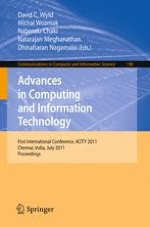2011 | Buch
Advances in Computing and Information Technology
First International Conference, ACITY 2011, Chennai, India, July 15-17, 2011. Proceedings
herausgegeben von: David C. Wyld, Michal Wozniak, Nabendu Chaki, Natarajan Meghanathan, Dhinaharan Nagamalai
Verlag: Springer Berlin Heidelberg
Buchreihe : Communications in Computer and Information Science
